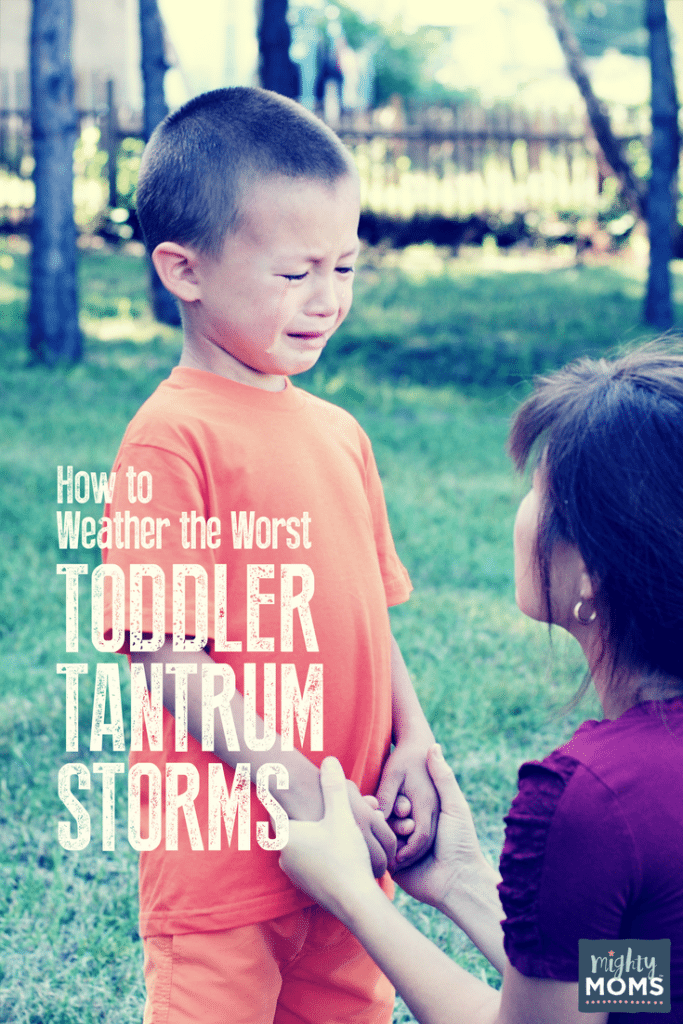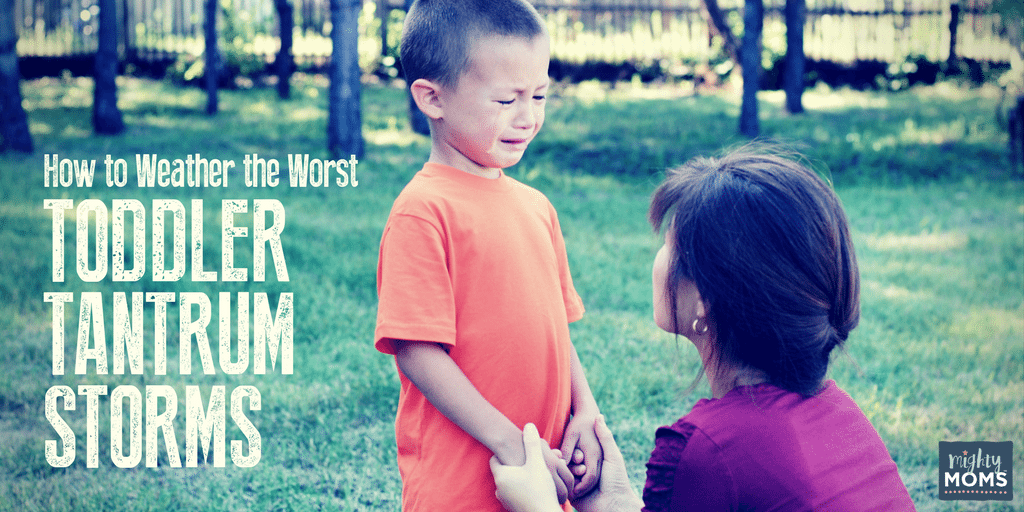The windows rattle.
The floor shakes slightly beneath your feet.
The lukewarm coffee in your mug ripples quietly as the storm’s momentum grows. You brace yourself, hang on tight, and throw your coffee in the microwave. You’re going to need back up.
Then the storm hits, only instead of heavy rain and thunder, you’ve been caught in waves of irrational screaming and flailing body parts.
It’s the tempest every mother fears: you’re in the middle of a toddler temper tantrum.
Toddler Tantrums:
You Can’t Avoid the Storm
The unfortunate nature of toddler tantrums is this: they are inevitable.
At some point (probably in the 1-3 year age range), your child will enter this phase of meltdowns and fits of crying.
Why?
- Frustration
- Desire to assert independence
- Stress
- Confusion
- Exhaustion
- You gave him the green plate instead of the blue one.
Whatever the reason, this is a natural developmental stage.
There is no one right way to respond to a meltdown. Each child differs in triggers, intensity, and overall need, so what works for one kid might not work for another. Dealing with your toddler’s temper tantrums is going to require a little bit of trial-and-error and HEAPS of grace.
Fortunately, I’m here to help you weather the storm, mama. (We just weathered Tropical Storm Bedtime. I’m in the thick of it too.)
This Toddler Tantrum Tornado is coming your way whether you like it or not, so what are you going to do to get ready? (Seriously. You don’t want to walk into a Toddler Gale without having a plan!)
Dealing with Toddler Tantrums:
Before the Storm Hits
Now is the time to be preemptive, before the toddler tantrum storm hits. Start by putting measures into place to help your child get through a meltdown or, even better, avoid one altogether.
Communicate Expectations with Your Child
Talk to your child about what you expect when his emotions get too high. In our house, we use phrases like, “Tantrums don’t mean we can hurt others” or “Toddler tantrums are not how you will get what you want.”
Additionally, take time to think through these questions:
- Is there a place your child will be removed to until he can calm down?
- Are there consequences for tantrums?
- Where will you be physically located during a temper tantrum? Will you stay beside him? Or wait at the bottom of the steps until he calms down?
Talk through the answers with your child periodically. If you make sure he knows the answers to all these questions, nothing will catch him off guard in the heat of the moment.
Know Your Child’s Triggers
Many temper tantrums can be attributed to sleepiness or hunger, but it’s also important to know what other unique things might push your kid over the edge. (In our house, a glass of water without an ice cube is enough to turn supper into a squall.)
Study your child for a few days and try to get to the root of his emotional outbursts. Understanding your child’s unique personality will be a huge help here. (Is she introverted and needs space? Is he prone to fits of rage when he gets too tired?)
Then, if possible, remove the toddler tantrum triggers.
- Go to the store when your child is well-fed and well-rested.
- Take the neon orange tutu out of the closet if you don’t want a big battle right before church.
- Leave the overstimulating birthday party before she becomes overwhelmed.
If it’s not possible to remove the triggers, put preemptive plans in place to ensure success. Does your child struggle with the transition from one task to another? Teach her how to recognize and handle those emotions, and warn her in advance when a change is coming.
Teach Your Child How to Calm Down on His Own
Ultimately, we want our kids to recognize feelings of anger, sadness, anxiety, etc. and know how to deal with them appropriately. Here are a few suggestions for teaching your child how to calm down on his own:
- Try reading books about feeling words together. In My Heart: A Book of Feelings and The Very Frustrated Monster are excellent for this!
- Hang feeling posters in the playroom. Teaching your child to use his words will give a voice to the emotions he feels during a toddler tantrum.
- Talk plainly about his feelings as often as possible. It’s as easy as, “I see that your body looks tight and your face looks unhappy. I think you’re mad. Do you want to talk about it before you feel like screaming?”
- Practice taking deep breaths together.
- Introduce a comfort item (a special blanket like this or stuffed animal like Humphrey the Elephant works well) that might help your child cool down.
- Consider shifting your approach to timeouts by allowing your child to remove himself from an overwhelming situation BEFORE his emotions get the best of him.
Dealing with Toddler Tantrums:
During the Storm
You’ve got your toddler tantrum preemptive measures in place. You’ve talked informally about feelings and set expectations in advance. Still, the storm’s coming. How do you withstand it once it hits?
Toddler Tantrum Rule #1: Stay Calm
Repeat after me: “My child is not trying to destroy me. My child is not trying to destroy me.”
Now alternate that with a few deep breaths and find your inner calm. Nothing good will come from losing your cool.
Your child needs you.
Speak firmly but controlled. Handle your own inner tantrum well, and she’ll start to learn from you. Even more importantly, she’ll learn to trust you.
*Breathe in…and out.*
Toddler Tantrum Rule #2: Know How Your Child Calms Down
A hug or a gentle touch might soothe one child while the same gesture might send another through the roof. Ignoring one kid’s tantrum might help him calm down more quickly while the same approach will only exasperate others.
Know what your child needs from you in order to calm down and consistently strive to provide that each time emotions run high.
Toddler Tantrum Rule #3: Don’t Give in to Demands
We all know this, but when you’re in the thick of it, it is so easy to want to give your kid the thing she is screaming for.
You think, “It’s not a big deal. It’s just a spoon. If I just give her the purple spoon instead of the pink one, she will stop screaming.”
But it IS a big deal.
If you give in to her screaming demands this time, she wins. Teaching her to scream for what she wants every time from now on.
That’s no good for anyone. There is a time to allow your child the purple spoon, but it’s not after she throws a huge fit.
Need some more suggestions on handling your toddler’s tantrums? Julie has you covered!
Dealing with Toddler Tantrums:
After the Storm
The sun will come out again, mama. The sun always comes out again! So, what now that the tantrum is over?
Give Positive Reinforcement
Mostly, give lots of hugs. Wrap your arms around that little tornado and tell him how much you love him–how happy you are that he is calm again.
Smile and laugh, and don’t let that blip on the radar ruin the rest of your day together.
Have a Follow-up Conversation
The timing of this will look differently depending on the kid, but at some point, after the emotion of the tantrum has passed, have some informal conversations about what happened:
- Point out what triggered the meltdown. “I think you felt frustrated because I asked you to stop playing, so we could eat. Is that right?”
- Praise anything he might have done well. “I noticed you trying to take deep breaths when you started getting frustrated. That was awesome!”
- Talk about things he can do better next time. “Next time, you can practice controlling your body when you get that frustrated feeling.”
- Practice some words he could have used instead of screaming. “Next time, use your words to tell me you feel frustrated. Say, ‘I’m feeling frustrated because I don’t want to stop playing!’”
Basically, cycle back to those initial expectations, and you should start to see improvements. Just remember to be consistent! Like so many other things, consistency in parenting yields long-term fruits!
If, however, you are concerned about the length, frequency, or intensity of your toddler’s tantrums, there is no shame in getting outside help.
“If you find yourself angry, resenting your child, unable to see his potential or dreading another day with him, it is time to enlist professional help.” – Mary Sheedy Kurcinka, Author of Raising Your Spirited Child
The Aftermath of the Toddler Tantrum Storm
Here’s the thing about storms: They pass.
Even though they may bring a little bit of destruction, they leave something even better behind.
Growth.
The way you approach the toddler tantrum phase will either cultivate her growth or stifle it.
You can teach your child to appropriately handle her emotions. And then, chances are, she will blossom into something really beautiful.
Now, should we take a few deep breaths together before you get started?
I hear it’s good to practice. *wink*
Do you have any tips for weathering toddler tantrum storms? Share it with the rest of us Storm Chasers below!
Have You Read These Yet?
- Hiking With a Toddler Doesn’t Have to be Hard
- 4 Proven Stress-Free Ways to Bathe Your Baby and Toddler Together
- 5 Things About Your Toddler’s Development That Will Surprise You
- Surviving ‘Til Nap Time: 10 Simple Toddler Activities to Entertain Your Tot
- 8 Mistakes Most Parents Make When Looking for a Good Preschool

We ♥ Citations
Raising Your Spirited Child: A Guide for Parents by Mary Sheedy Kurcinka
Managing Tantrums. PsychologyToday.com
Temper Tantrums. HopkinsMedicine.org

